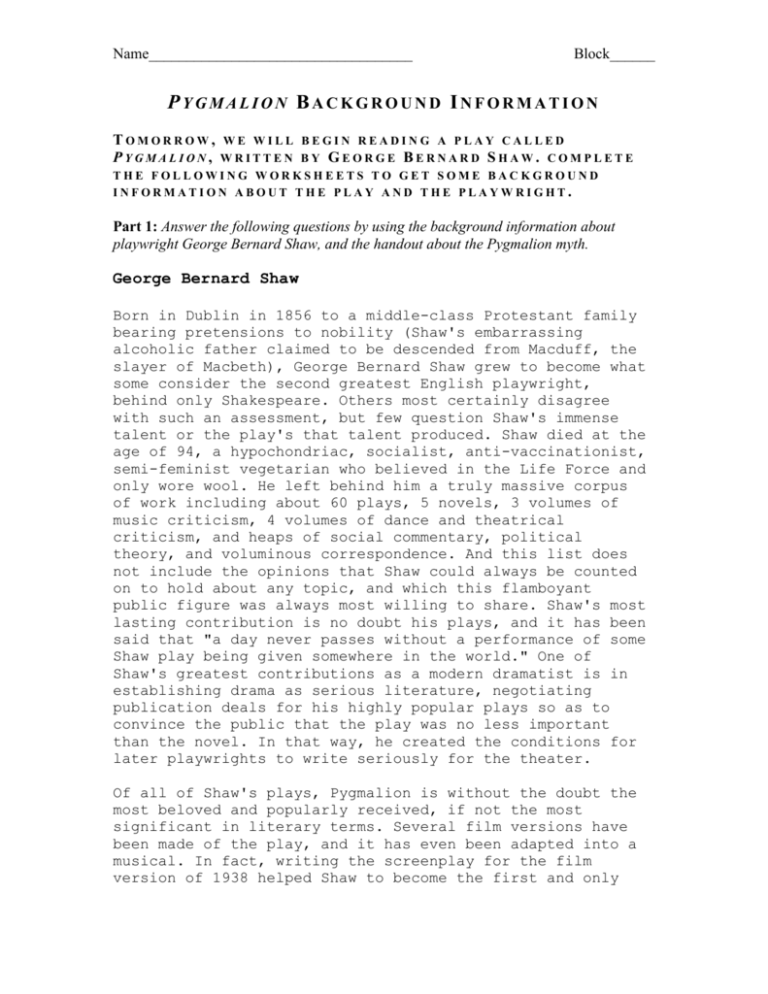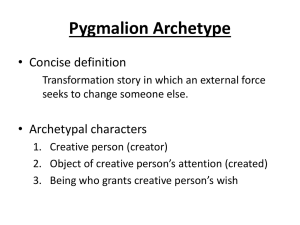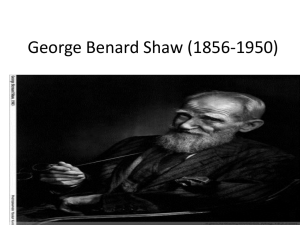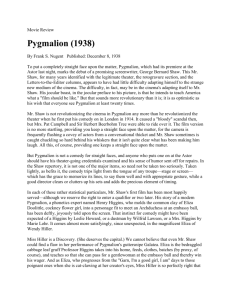1PygBackgroundPaper
advertisement

Name___________________________________ Block______ PYGMALION BACKGROUND INFORMATION TOMORROW, PYGMALION, WE WILL BEGIN READING A PLAY CALLED WRITTEN BY GEORGE BERNARD SHAW. COMPLETE THE FOLLOWING WORKSHEETS TO GET SOME BACKGROUND INFORMATION ABOUT THE PLAY AND THE PLAYWRIGHT. Part 1: Answer the following questions by using the background information about playwright George Bernard Shaw, and the handout about the Pygmalion myth. George Bernard Shaw Born in Dublin in 1856 to a middle-class Protestant family bearing pretensions to nobility (Shaw's embarrassing alcoholic father claimed to be descended from Macduff, the slayer of Macbeth), George Bernard Shaw grew to become what some consider the second greatest English playwright, behind only Shakespeare. Others most certainly disagree with such an assessment, but few question Shaw's immense talent or the play's that talent produced. Shaw died at the age of 94, a hypochondriac, socialist, anti-vaccinationist, semi-feminist vegetarian who believed in the Life Force and only wore wool. He left behind him a truly massive corpus of work including about 60 plays, 5 novels, 3 volumes of music criticism, 4 volumes of dance and theatrical criticism, and heaps of social commentary, political theory, and voluminous correspondence. And this list does not include the opinions that Shaw could always be counted on to hold about any topic, and which this flamboyant public figure was always most willing to share. Shaw's most lasting contribution is no doubt his plays, and it has been said that "a day never passes without a performance of some Shaw play being given somewhere in the world." One of Shaw's greatest contributions as a modern dramatist is in establishing drama as serious literature, negotiating publication deals for his highly popular plays so as to convince the public that the play was no less important than the novel. In that way, he created the conditions for later playwrights to write seriously for the theater. Of all of Shaw's plays, Pygmalion is without the doubt the most beloved and popularly received, if not the most significant in literary terms. Several film versions have been made of the play, and it has even been adapted into a musical. In fact, writing the screenplay for the film version of 1938 helped Shaw to become the first and only Name___________________________________ Block______ man ever to win the much coveted Double: the Nobel Prize for literature and an Academy Award. 1. When and where was Shaw born? Place:_____________________________ Date:__________________________ 2. List three facts about George Bernard Shaw’s family. a. b. c. 3. List SIX interesting facts that you learned about Shaw from the information given: a. b. c. d. e. f. Name___________________________________ PART2: PYGMALION AND Block______ GREEK MYTHOLOGY George Bernard Shaw’s play, Pygmalion, is set in 1913 London, but it is loosely based on a Greek myth about a sculptor named Pygmalion. Use the following explanation of the Greek Myth of Pygmalion to answer the questions that follow. Greek Myth of Pygmalion Pygmalion was a gifted sculptor from Cyprus who had no interest in the local women as he found them immoral and frivolous. Instead Pygmalion concentrated on his art until one day he ran across a large, flawless piece of ivory and decided to carve a beautiful woman from it. When he had finished the statue, Pygmalion found it so lovely and the image of his ideal woman that he clothed the figure and adorned her in jewels. He gave the statue a name: Galatea, sleeping love. He found himself obsessed with his ideal woman so he went to the temple of Aphrodite to ask forgiveness for all the years he had shunned her and beg for a wife who would be as perfect as his statue. Aphrodite was curious so she visited the studio of the sculptor while he was away and was charmed by his creation. Galatea was the image of herself. Being flattered, Aphrodite brought the statue to life. When returned Pygmalion to his home, he found Galatea alive, and humbled himself at her feet. Pygmalion and Galatea were wed, and Pygmalion never forgot to thank Aphrodite for the gift she had given him. He and Galatea brought gifts to her temple throughout their life and Aphrodite blessed them with happiness and love in return. 1. Who was Pygmalion? 2. What did Pygmalion carve out of ivory? 3. Why didn’t Pygmalion like the local women? (Answer without using the words immoral or frivolous) 4. For what did Pygmalion pray to Aphrodite? Name___________________________________ 5. What kind of life did Pygmalion and Galatea lead in the end? Block______









